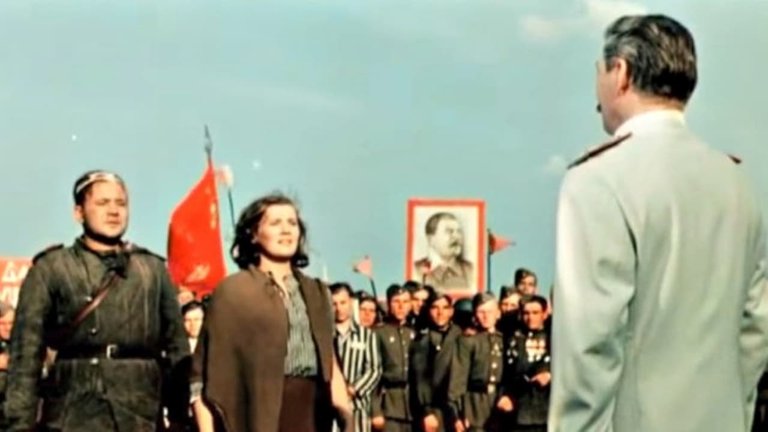
In the annals of history, few individuals have wielded as much power as Soviet leader Joseph Stalin did in the years following World War II. Like many autocrats before him, Stalin spared no expense in constructing monuments and cultural creations that would reflect his influence. One such tribute took the form of numerous films featuring the Soviet leader, with actor Mikheil Gelovani – fellow Georgian selected by Stalin himself for his uncanny resemblance and mannerisms - portraying the dictator in several notable productions. Among these cinematic works, The Fall of Berlin, 1950 war epic directed by Mikheil Chiaureli, stands out for being considered the crowning achievement of Stalinist cinema at the time.
The Fall of Berlin tackles the events of World War II, but its narrative begins during peacetime, prior to Operation Barbarossa. The film's nominal protagonist, played by Boris Andreyev, is Alexei "Alyosha" Ivanov, a steelworker who becomes famous for breaking production records. He is in love with schoolteacher Natasha Rumyantseva, portrayed by Marina Kovaleva, but his bashfulness prevents him from expressing his feelings towards her. An audience with Stalin in Moscow - granted due to Ivanov's remarkable labor achievements - serves as a turning point, as the Soviet leader offers advice on how to pursue his love interest.
Following this pivotal meeting, Alyosha and Natasha begin their romantic relationship, only for their happiness to be rudely interrupted by the German invasion. Alyosha sustains an injury during a Luftwaffe bombing raid, awakening months later in a Moscow hospital to learn that Natasha has been taken captive by the Germans and transported to Germany as a slave labourer. Determined to set her free, Alyosha volunteers for the Red Army, participating in the defence of Moscow before joining the battles at Stalingrad and other crucial theatres of war. As the tide turns in favor of the Allies, the film culminates with the final Soviet push on Berlin. Adolf Hitler, portrayed by Vladimir Savelyev, clings to the hope that he can still win by exploiting divisions among his enemies.
The Fall of Berlin has been traditionally described as a piece of crude propaganda and an embodiment of everything wrong about Soviet cinema - a film burdened by the dogmatic style of Socialist Realism, a narrow and biased interpretation of World War II through the prism of Soviet official ideology, portrayal of Stalin as a wise, infallible deity-like leader, and, finally, a historical film that at times openly falsifies actual history.
Despite these criticisms, it would be unfair to characterize The Fall of Berlin as worthless or not to admit that there was some impressive effort and genuine talent invested in its production. Chiaureli originally intended to make the film as a celebration of Stalin's 70th birthday, and because of this, he was given financial, logistical, and technical resources that even his Hollywood peers at the time could only dream about. The most important of these resources was Agfacolor, a colour film technology developed in pre-WW2 Germany, with stocks captured by Soviets in Berlin at the end of the war and later used in many high-budget productions, including this film.
The co-operation of the Soviet Army, which borrowed tens of thousands of soldiers, tanks, and other pieces of equipment to reconstruct battles, was also crucial. The actual battle for Berlin was reconstructed partly on the streets of the city, partly in famous Babelsberg studios, and partly in Mosfilm studios in Moscow, where an entire section of German capital was built only to be completely wrecked. The Fall of Berlin not only looked but also sounded impressive, thanks to the strong musical score written by famous composer Dmitry Shostakovich.
The result is truly impressive, showcasing the logistical and technical abilities of Soviet cinema while also presenting the most spectacular re-enactment of war by its time. Spectacular battle scenes won't be matched for decades, until the development of CGI technology. This was recognized even in the West during the film's original distribution, when critics praised its technical merits despite pointing out to the propaganda of Cold War adversaries.
The script, co-authored by Chiaureli and Pyotr Pavlenko, suffers not only from propaganda limitations but also from structural problems. The "regular" plot featuring Alyosha and Natasha is put to the back-burner for much of the film's two-and-a-half-hour running time and gets resolved in an unconvincing or disorderly manner. Scenes featuring actual historical personalities and events are much more interesting, including the Yalta conference where Viktor Stanytsin is quite convincing as Winston Churchill and Hitler's last stand in the bunker, where Vladimir Savelyev eerily embodies Nazi leader with mannerisms and style that would be repeated in many later films and TV shows.
Some of the problems with the script, including gaping plot holes and unexplained cuts, can be explained by shifting political winds following Stalin's death in 1953. Immediately afterwards, Lavrentii Beria, Stalin's dreaded chief of secret police, fell out of favour, and as a result, all of the scenes in which his character, played by Nikolai Mordvinov, appears were removed and apparently lost.
The Fall of Berlin fared even worse three years later, when Nikita Khruschev, in his famous speech at XX Congress of Communist Party, pointed at the film as an example of Stalin-era "cult of personality." In subsequent process of de-Stalinization, The Fall of Berlin became inconvenient and was banned in Soviet Union and other countries of East Bloc, with exception of Mao's China. The ban was ironically lifted only after the fall of Communism and the audience in Russia and the rest of world finally got the opportunity to watch the film unburdened by Cold War politics and judge it by its own merit.
Despite its flaws, The Fall of Berlin remains an intriguing glimpse into the Soviet perspective on World War II and the era of Stalin's rule.
RATING: 6/10 (++)
Blog in Croatian https://draxblog.com
Blog in English https://draxreview.wordpress.com/
InLeo blog https://inleo.io/@drax.leo
Hiveonboard: https://hiveonboard.com?ref=drax
Rising Star game: https://www.risingstargame.com?referrer=drax
1Inch: https://1inch.exchange/#/r/0x83823d8CCB74F828148258BB4457642124b1328e
BTC donations: 1EWxiMiP6iiG9rger3NuUSd6HByaxQWafG
ETH donations: 0xB305F144323b99e6f8b1d66f5D7DE78B498C32A7
BCH donations: qpvxw0jax79lhmvlgcldkzpqanf03r9cjv8y6gtmk9